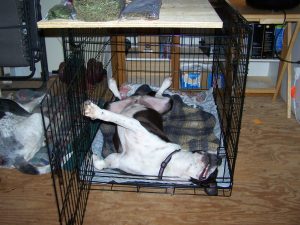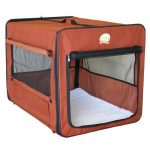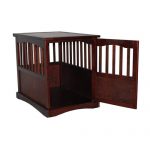Originally published November 21, 2014

When used properly, crate training provides you and your dog with multiple benefits. For you it provides a simple, effective means of restricting your dog when you cannot provide close supervision. If your dog is an explorer, he may get into things that will harm him. If she’s a chewer, your home may suffer from allowing her to roam unsupervised. Crating also helps with housebreaking because a dog has a natural aversion to soiling its own sleeping space.
For your dog crate training offers a safe haven, a room or space of his own. It is a familiar place. Whether you go on the road or just move around a large home, having a place of his own brings your dog a feeling of safety. If your dog is ill or just been spayed or neutered, a familiar crate is quite comforting. A crate is effective in combating separation anxiety or fear of a thunderstorm because of the snug, safe feeling an enclosed crate can provide.
Types of Crate
The two most common types of crate are the welded wire crate and the molded plastic transport box. But also available are a soft crate, a tent crate, and a few variations on these themes.
Wire Crate
Welded wire crates (pictured above) come in a variety of sizes and prices. They are made to fold down into a flat “brief-case” type bundle for moving around or storage. They have a plastic tray in the bottom and most come with an end door and a side door.
Upsides of a wire crate are high visibility, compact storage, and low(ish) cost. If you are tending a dog that needs monitoring (as we do with heartworm positive dogs) the see-through quality is a plus. They fold into a compact bundle and store well. The cost for the large crates we use for the 50 to 90 pound dogs we usually foster runs around $80.00.
The down sides are that the open architecture does not serve well for anxious dogs: you have to cover them with blankets, and some brands are rather flimsily built. This is one product that you need to do homework and find a reliable brand or even a mildly determined dog will break the welds and dismantle the crate.
Plastic Transport Box
 Designs vary, but most of these are a two-piece molding that fits together like a clam-shell, with a wire door in one end. The halves are held together by toggles or bolts for relatively easy disassembly. Most will have ventilation holes or slots in the sides. The larger boxes generally have lifting handles molded into the sides of the box. The transport boxes are made to be heavy enough to safely transport animals in a vehicle. Plastic crates may not be, check the rating if you need the added safety.
Designs vary, but most of these are a two-piece molding that fits together like a clam-shell, with a wire door in one end. The halves are held together by toggles or bolts for relatively easy disassembly. Most will have ventilation holes or slots in the sides. The larger boxes generally have lifting handles molded into the sides of the box. The transport boxes are made to be heavy enough to safely transport animals in a vehicle. Plastic crates may not be, check the rating if you need the added safety.
These are good for anxious dogs or animals that just need a more secure feeling to their “room”. The halves come apart and nest together for more compact storage, but not as compact as a wire crate.
These boxes are our crate of choice for determined dogs because a good one will stand up to escape attempts better than a wire crate. The door is the only weak spot: look for heavy wire, small openings, and great welding.
These are a little more expensive for a good brand than the wire crates. The large version we use costs us around $100.00. There are cheaper brands that would work fine for a calm, crate trained dog. Since the dogs we work with are transitory, once we get to that point, they go on to live in someone else’s home. We need the armored version.
Soft Crates
 Soft crates and tent crates are essentially the same except for their shape. Both are made primarily of fabric and have a light frame inside to hold their shape. Both fold up exceptionally compactly and are light. These are good as temporary restraint for a compliant dog on the go or as mobile crates in your home. They are not suitable for transporting in a vehicle, or for crate training a dog.
Soft crates and tent crates are essentially the same except for their shape. Both are made primarily of fabric and have a light frame inside to hold their shape. Both fold up exceptionally compactly and are light. These are good as temporary restraint for a compliant dog on the go or as mobile crates in your home. They are not suitable for transporting in a vehicle, or for crate training a dog.
Hybrids
 There are also dog crates that are made to serve dual purpose as an end table or coffee table. This can be a space saving advantage or can be used simply to have a better looking place for your dog. Wire or plastic crates are not especially elegant, after all.
There are also dog crates that are made to serve dual purpose as an end table or coffee table. This can be a space saving advantage or can be used simply to have a better looking place for your dog. Wire or plastic crates are not especially elegant, after all.
In most cases these will be an end-goal acquisition. They are expensive (several hundred dollars) and easily damaged. Once a dog is trained, and if you feel the need for a permanent crate, these are an attractive option. Do the crate training in a wire or plastic crate, then upgrade.
Training Tips
- First and foremost, never use the crate as punishment. You want your dog to think of his crate as his bed, his room, his safe place.
 As such, make it comfy! When Cochise went through his heart worm treatment (and was quite miserable), we put a couple of quilts, a blanket and a pillow in there. Aside from the sofa and our bed (which were off limits to him) his crate was the most comfy place in the house. Even after being cured, his crate was his favorite place to rest.
As such, make it comfy! When Cochise went through his heart worm treatment (and was quite miserable), we put a couple of quilts, a blanket and a pillow in there. Aside from the sofa and our bed (which were off limits to him) his crate was the most comfy place in the house. Even after being cured, his crate was his favorite place to rest.
- If your dog is destructive, try shredded paper instead of blankets until you get him dissuaded of that habit. Many businesses shred documents and will give you bags of shredded paper if you explain why you want it. Use strips not the little diamond cross-cut shreds.
- In either case, avoid quilts at first because the fabric coverings are thin and easily torn. A dog’s nesting can easily damage them unintentionally. Blankets, especially polar fleece, are warm, durable and wash well. If cost is an issue, haunt local thrift stores where used blankets can be had inexpensively.
- Size the crate appropriately. The dog needs to be able to turn around inside, but running laps is not needed. Too small will be claustrophobic, too large can be counter-productive and even dangerous.
- Get the dog to walk in on her own. Toss in a treat or favorite toy as bait if you must, but try not to shove them in. They resent that highly. Work toward obedience to a voice command.
- Once they get accustomed to it being their space, leave the door open whenever possible. Fasten the door only when confinement is necessary.
- If she fusses or digs at the door do not let her out to calm her down. This reinforces the negative behavior: much like a child having a temper tantrum, ignore the bad behavior and wait for it to subside before releasing her.
- Using a crate during house breaking works much better than using a pen or enclosed area, a larger space allows room to select an acceptable (to the dog) area to relieve himself. If pad training is in fact your objective: OK. If the objective is training him to always go outside, pad training is counter-productive for you will have to un-train that training eventually.
- There are limits to how long any dog can hold their bowels and bladder. Take the dog out for relief often enough that he does not feel imprisoned. This is especially important in a puppy, an elderly dog, or a nervous dog.
- Make sure your dog gets play time outdoors often enough to keep them fit. Crating a dog for long periods can cause muscle debilitation and health issues.
- Once you can trust your dog not to destroy your home, leave the crate door open and let them return to the crate to rest, but there should be no need for confinement in normal circumstances.
Lupa Begins Crate Training
Lupa’s First Sleep-Over from Doug Bittinger on Vimeo.
More on Crate Training:
- http://www.labradortraininghq.com/labrador-training/how-to-crate-train-a-puppy/
- http://www.aspca.org/pet-care/virtual-pet-behaviorist/dog-behavior/weekend-crate-training
- http://www.humanesociety.org/animals/dogs/tips/crate_training.html
- http://www.dogingtonpost.com/ask-the-trainer/
- https://www.totallygoldens.com/crate-training-your-puppy-or-dog/
- https://entirelypomeranian.com/how-to-house-train-a-dog.html
- https://breedadvisor.co.uk/dog-training-guide/
| If you enjoy our updates, Doggy Tales, and educational articles consider subscribing for notices when new pieces are posted. It’s painless and you can unsubscribe any time you want. Your e-mail address is used ONLY to deliver these notices. | [email-subscribers namefield=”YES” desc=”” group=”Public”] |



